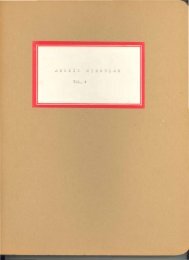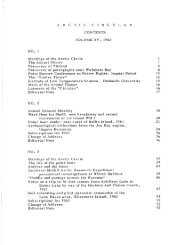Volume 11, 1958 - The Arctic Circle - Home
Volume 11, 1958 - The Arctic Circle - Home
Volume 11, 1958 - The Arctic Circle - Home
You also want an ePaper? Increase the reach of your titles
YUMPU automatically turns print PDFs into web optimized ePapers that Google loves.
VOL XI No I<br />
THE ARCTIC CIRCULAR<br />
<strong>11</strong><br />
For photographing the biological subjects, a variety of<br />
techniques was used. Flocks of geese, herds of muskox, and arctic<br />
hares were photographed from a helicopter belonging to the C.G.S.<br />
d'Iberville. Muskox were successfully stalked on foot where ground<br />
relief gave concealment, or approached directly in the open nn fiat<br />
areas. Birds were photographed in three ways: a remote control<br />
was used in some cases, a duck hunters' type of "blind" on others,<br />
and long lenses were employed where no nest was present to draw<br />
the birds back to a particular spot. A gyrfalcon fortunately accepted<br />
a blind and returned to an old squaw duck which it had previously<br />
wounded, and a wolf was photographed when it approached a greater<br />
SnOw goose nest as the writer sat in a nearby blind. Extreme<br />
close-ups of flowering plants, mosses, lichens, and fungi were made<br />
with lens tubes. Marine specimens were photographed by artificial<br />
light in aquaria.<br />
<strong>The</strong> writer wishes to thank Mr. S.D. MacDonald for his<br />
information and advice and Mr. Welland Phipps for his personal<br />
efforts which made it possible to film many otherwise inaccessible<br />
subjects. <strong>The</strong> cooperation and assistance of the joint Canadian and<br />
American staff .t Eureka, Mr. R. Ethrington O.I.C. (1956), is<br />
gratefully acknowledged.<br />
Ornithological research at Pelly Bay in the summer of 1956.<br />
Andrew Macpherson<br />
By<br />
In 1955 I began a study of the relationships of Canadian<br />
<strong>Arctic</strong> Larus gulls, under the direction of Dr. M.J. Dunbar of<br />
McGill University. Field work was carried out that summer near<br />
Cape Dorset ,southwest Baffin Island, with a grant from the National<br />
Research Council and the preliminary field results have been reported<br />
in the Circular (Vol. 8, No.4, pp. 74-8). <strong>The</strong> project was continued<br />
in 1956 with funds provided by the <strong>Arctic</strong> Institute of North America<br />
through the Banting Committee.<br />
Pelly Bay, at the head of the Gulf of Boothia, was<br />
selected as a suitable place for the second season's field work.<br />
Information from the Pelly Bay mission indicated the presence<br />
nearby of both cliff- and ground-nesting gulls. <strong>The</strong>se proved to be<br />
Thayer's Gulls and Glaucous Gulls. Unfortunately no American<br />
Herring Gulls were found at Pelly Bay, although they OCCur at a<br />
higher latitude on Melville Peninsula.












